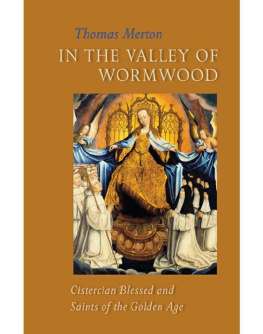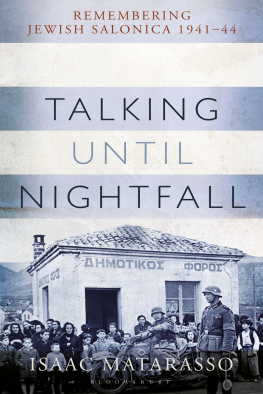Pauline M. Matarasso (ed) - The Cistercian World: Monastic Writings of the Twelfth Century
Here you can read online Pauline M. Matarasso (ed) - The Cistercian World: Monastic Writings of the Twelfth Century full text of the book (entire story) in english for free. Download pdf and epub, get meaning, cover and reviews about this ebook. year: 1993, publisher: Penguin Classics, genre: Art. Description of the work, (preface) as well as reviews are available. Best literature library LitArk.com created for fans of good reading and offers a wide selection of genres:
Romance novel
Science fiction
Adventure
Detective
Science
History
Home and family
Prose
Art
Politics
Computer
Non-fiction
Religion
Business
Children
Humor
Choose a favorite category and find really read worthwhile books. Enjoy immersion in the world of imagination, feel the emotions of the characters or learn something new for yourself, make an fascinating discovery.
- Book:The Cistercian World: Monastic Writings of the Twelfth Century
- Author:
- Publisher:Penguin Classics
- Genre:
- Year:1993
- Rating:3 / 5
- Favourites:Add to favourites
- Your mark:
- 60
- 1
- 2
- 3
- 4
- 5
The Cistercian World: Monastic Writings of the Twelfth Century: summary, description and annotation
We offer to read an annotation, description, summary or preface (depends on what the author of the book "The Cistercian World: Monastic Writings of the Twelfth Century" wrote himself). If you haven't found the necessary information about the book — write in the comments, we will try to find it.
The Cistercian World: Monastic Writings of the Twelfth Century — read online for free the complete book (whole text) full work
Below is the text of the book, divided by pages. System saving the place of the last page read, allows you to conveniently read the book "The Cistercian World: Monastic Writings of the Twelfth Century" online for free, without having to search again every time where you left off. Put a bookmark, and you can go to the page where you finished reading at any time.
Font size:
Interval:
Bookmark:

THE CISTERCIAN WORLD
Pauline Matarasso read modern languages at Lady Margaret Hall, Oxford, and was awarded a Doctorat de lUniversit de Paris in 1958. Her thesis, Recherches historiques et littraires sur Raoul de Cambrai , was published in 1962. She has also translated The Quest of the Holy Grail and Aucassin and Nicolette and Other Tales for Penguin Classics, and has written an in-depth study of the former, The Redemption of Chivalry , published in 1979. Queens Maid , her combined biography of Anne of France, Anne of Brittany and Louise of Savoy, will be published by Ashgate in 2001.
The Cistercian World
MONASTIC WRITINGS OF THE TWELFTH CENTURY
Translated and Edited with an Introduction by
PAULINE MATARASSO
PENGUIN BOOKS
PENGUIN BOOKS
Published by the Penguin Group
Penguin Books Ltd, 80 Strand, London WC2R 0RL, England
Penguin Putnam Inc., 375 Hudson Street, New York, New York 10014, USA
Penguin Books Australia Ltd, 250 Camberwell Road, Camberwell, Victoria 3124, Australia
Penguin Books Canada Ltd, 10 Alcorn Avenue, Toronto, Ontario, Canada M4V 3B2
Penguin Books India (P) Ltd, 11 Community Centre, Panchsheel Park, New Delhi 110 017, India
Penguin Books (NZ) Ltd, Cnr Rosedale and Airborne Roads, Albany, Auckland, New Zealand
Penguin Books (South Africa) (Pty) Ltd, 24 Sturdee Avenue, Rosebank 2196, South Africa
Penguin Books Ltd, Registered Offices: 80 Strand, London WC2R 0RL, England
www.penguin.com
First published 1993
Copyright Pauline Matarasso, 1993
All rights reserved
The moral right of the editor and translator has been asserted
Except in the United States of America, this book is sold subject to the condition that it shall not, by way of trade or otherwise, be lent, re-sold, hired out, or otherwise circulated without the publishers prior consent in any form of binding or cover other than that in which it is published and without a similar condition including this condition being imposed on the subsequent purchaser
ISBN: 9781101491805
To the community of Mount Saint Bernard, who have made me welcome over the years and provided a living witness to the continuing vitality of their tradition.Contents
Acknowledgements
My particular thanks to Hilary Costello O.C.S.O . for acting as a sounding-board, wrestling with linguistic teasers, fielding queries and undertaking extra manual labour in ferrying books between library and guest house, all with unfailing cheerfulness; to Professor Brian Patrick McGuire, head of the Medieval Centre at Copenhagen University, for much friendly encouragement and wise advice; to Jeannine Alton for the unfailing support of her friendship, and for leading me to both title and cover illustration; and to my son Franois for gifts of mind and heart placed at my disposal during the preparation of this book.
Introduction
The ruins of the great Cistercian houses that sprang up all over Europe in the twelfth and thirteenth centuries stand today as silent witnesses to an Order for which silence was an integral part of the spiritual life. It is not too hard, when wandering among the blanched and fretted remains, to rebuild and even to repeople in the minds eye the abbeys in their later splendour. It is harder to understand what took men to the first foundations, what induced them to settle in small groups in outlandish and infertile spots, to opt for a way of life so austere in the early years that their own contemporaries viewed it with a mixture of horror and admiration. Happily, they left another witness, less monumental but less subject to decay: the written word. They were not only great exponents of monastic spirituality; they chronicled their beginnings and, as one generation of monks followed another, committed to parchment all the memorabilia of the heroic years in an attempt to fan their own zeal to a comparable flame.
The Cistercian Order came into being in Burgundy at the turn of the twelfth century as part of a movement of radical renewal then gathering momentum. It was an offshoot of the Benedictine tree, and it was not the first time that a fresh wind had shaken those spreading branches. For over a hundred years the great Burgundian abbey of Cluny, itself the product of an earlier reform, had exerted a revitalizing influence, both directly and through its many dependent and affiliated houses. Its power was now at its height, its fervour perhaps on the wane. The Cluniacs observed the spirit, as they saw it, of St Benedicts Rule, adapting the letter to the conditions of their time. A greatly lengthened liturgy, in particular, left the monks no time for manual labour. The life was exacting but not harsh, and the Order, though subject only to Rome, remained tightly enmeshed in feudal society.
Rapid economic and social changes in the late eleventh century ushered in a period of self-questioning and a search for identity among different classes and groups, not least or last the professed religious. Neither the traditional Benedictine abbeys nor Cluny with its liturgical splendours satisfied a growing hunger for the Gospel values of poverty and simplicity. Those years saw the founding of half a dozen new orders dedicated to prayer and ascesis; of these the Cistercians, or white monks, were to become by far the largest and indeed in time absorbed some of the others. But nothing in their beginnings gave any hint of the phenomenally rapid growth to follow. The initial impetus was given in 1098 by Robert, Abbot of Molesmes. Feeling that this community, which he had himself established twenty years before, was falling short of his vision, he went in search of greater isolation and austerity, taking a score of brothers with him. They settled in a marshy clearing in the woodland south of Dijon bearing the name of Cteaux. Here they found that howling waste of the wilderness through which God led his people after their escape from slavery in Egypt. The communitys experience of living out the exodus in all its rigour proved no less searching than the Israelites, and manna was not at once forthcoming. The first setback was the loss of their leader. Abbot Roberts abandoned flock at Molesmes sued to the Pope for his return, and the following year he obeyed an injunction to rejoin them. At least half the brothers chose to accompany him back, and Cistercian chroniclers never quite forgave what they saw, perhaps unjustly, as his return to the fleshpots of Egypt. The remaining monks, first under Abbot Alberic, then under the authority of the Englishman Stephen Harding whose Charter of Charity was to guarantee unity and uniformity throughout the Order, eked out in the early years an existence of great hardship.
Their professed aim was a literal enactment of St Benedicts Rule. The overgrown office was pruned back to restore the right balance of prayer, lectio divina (the meditative reading of Scripture and the Fathers) and manual labour. The monks day varied with the seasons: more time for reading in the winter, longer hours in the fields during the summer months. The biggest break with the recent monastic past was the Orders rejection of any interdependence with feudal society. Gifts of land were accepted, but the Order had neither tithes, tenants nor serfs. The world was kept at bay: no schools, no parishes, no funeral ceremonies for lay patrons, no relics for public veneration, hence no pilgrims and no crowds. Breaking with custom was not easy; it was only under Stephen Harding that the community succeeded in preventing Hugh II, Duke of Burgundy and a good friend of the abbey, from holding his court on major feasts in the church his father had built for them.
The centralized yet flexible structure that was to preserve the Order from anarchy and fragmentation during its period of meteoric growth was the fruit of the organizational genius of Stephen Harding. Under his rule the New Monastery, as it was called, began to prosper. Gifts of land increased and granges were established to exploit those farthest from the monastery. This was to lead in time to a major new initiative, a break with custom and, indeed, the Rule. Finding it impossible to cover fully both their choir duties and their field work, and determined not to fall back into the trap of the manorial system, the white monks introduced a lay brotherhood of men under vows but living apart under a simplified regime. Within a generation these had become the chief labour force.
Next pageFont size:
Interval:
Bookmark:
Similar books «The Cistercian World: Monastic Writings of the Twelfth Century»
Look at similar books to The Cistercian World: Monastic Writings of the Twelfth Century. We have selected literature similar in name and meaning in the hope of providing readers with more options to find new, interesting, not yet read works.
Discussion, reviews of the book The Cistercian World: Monastic Writings of the Twelfth Century and just readers' own opinions. Leave your comments, write what you think about the work, its meaning or the main characters. Specify what exactly you liked and what you didn't like, and why you think so.












